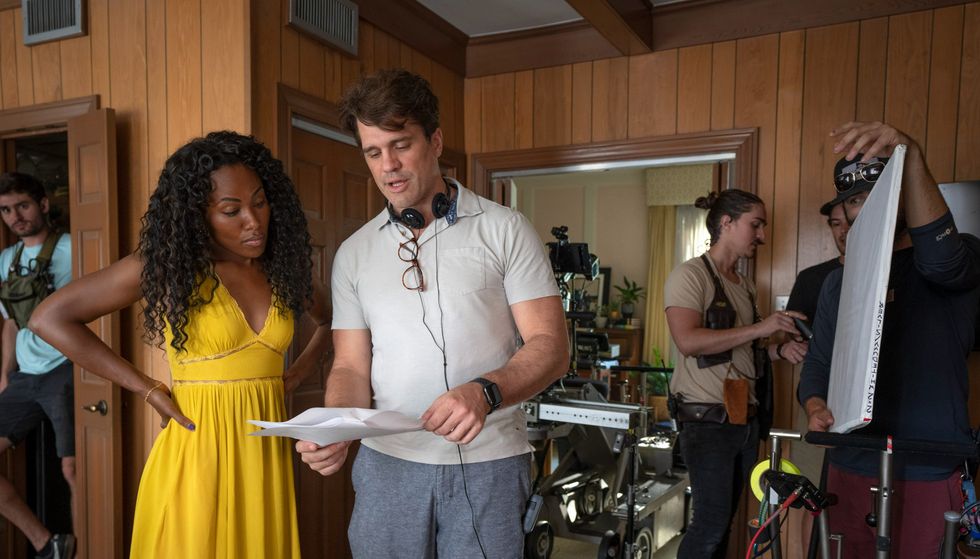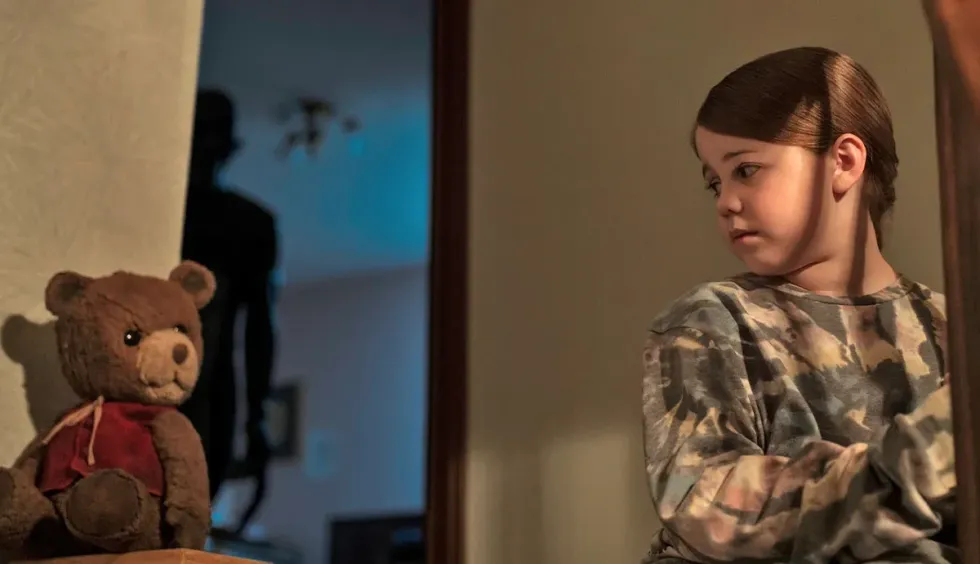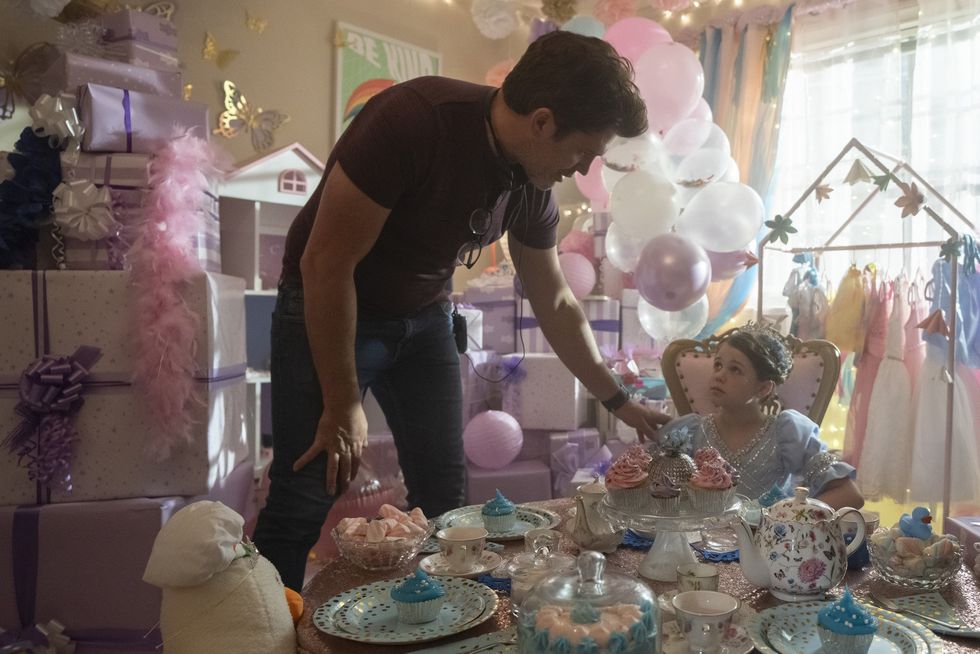Horror Tips from Director Jeff Wadlow and the Set of 'Imaginary'
We speak with the Blumhouse director about his new film.

DeWanda Wise in Imaginary
You might be aware that we're roughly halfway to Halloween. That is basically a holiday in my books, and I'm ready as ever to get back into the scary movie spirit. So when we had the chance to jump on a Zoom call with director Jeff Wadlow, I was excited to dive right into how his most recent movie Imaginary was made, his use of practical effects, and more.
The film is about a blended family returning to Jessica's (DeWanda Wise) childhood home, where she has repressed memories surface about a malevolent imaginary friend that is now seemingly going after her stepdaughter, Alice (Pyper Braun). That friend takes the form of Chauncey, a creepy teddy bear.
Open the doors to the world of imagination that is filmmaking, and confront the monsters with this advice from Wadlow. Enjoy!
Imaginary (2024) Official Trailer – DeWanda Wise, Tom Payne, Taegen Burnswww.youtube.com
Editor's note: This conversation has been edited for length and clarity.
No Film School: I would love to start with your background on this project.
Jeff Wadlow: I originated it, so I had an over all deal at Blumhouse, and Jason challenged me to come up with a more sort of classic Blumhouse movie, a supernatural Horror Family in one home. There's a bump in the night, that kind of thing.
I was taking meetings with writers and Greg Erb is a longtime friend of mine friends for 20 years. So Greg and Jason, who's Greg's writing partner, they came down to Blumhouse and we were just brainstorming. They wanted to do something with a evil teddy bear. I wanted to do something with an evil imaginary friend. We put our heads together and sort of came up with a story that checked all the boxes for Jason's mandate.
NFS: I love to ask about challenges on films. Is there a sequence on this one that was particularly challenging, and why?
Wadlow: I try to do a lot of things in-camera. It's more cost-effective. I just think it's cooler at the end of the day and try to just use VFX to augment when necessary. There's a couple sequences where, especially in the third act, when we're in the imaginary world—spoilers—where we're looking in on sets or scenes or things that have already happened or places we've already visited, and I wanted that to be seamless without the effects.
So a lot of times one angle would be on one set, and then I would shoot a different angle, a piece of the coverage on a totally different set because I was trying to make it look like the worlds were overlapping when they actually weren't. And so that was quite challenging to keep track of just the performances, the lighting, the continuity, how I was playing to cut the scene so that it would still feel like even though I'm intercutting two angles, it would feel like we're in the same moment, even though they were probably shot two weeks apart.
NFS: I noticed the use of practical effects, especially with costuming in that third act, and was curious about that choice, but it sounds like you prefer to work that way.
Wadlow: Well, again, it's cheaper at the end of the day. As long as you're smart about it and you commit to choices ahead of time, it's going to be more cost-effective than visual effects. It also creates a reality for the actors, which I love. It's easier for the actors to perform when they're looking at a real monster, when they're wearing their actual costume, when they're on an authentic set. And third reason I prefer it is there's a verisimilitude that the audience can feel. They believe in the world. So even when you might be tweaking things or augmenting things with visual effects, by and large, they can feel the weight and reality and gravity of the thing you're working with if it is practical.

NFS: Something that's so important about horror is that buildup of tension and then the release. I would love to know your advice for achieving that, whether it's in the edit or in on the page. How do you approach that tension?
Wadlow: You just got to be patient. I think most storytellers' biggest fear is boring their audience. It's certainly mine.
So my instinct is to just go pick it up, pick it up, take out the slow parts, just get to the next story point, get to the next beat. Just keep soldiering ahead, trying to stay in front of the audiences, their expectations. Just try to stay in front of it. But with horror, you actually have to fight that instinct. You have to slow down, you have to take a breath, you have to allow the audience to sit with the tension. You have to be okay with not providing answers to questions, and that can be challenging.
NFS: Do you see a mistake that novice directors often make? And how should they avoid it? As a new feature director, maybe you're coming off a short.
Wadlow: I would say the biggest mistake that I hear about, it's not something that I really witness that often because there's usually only one director on the set, but the biggest mistake I hear about is that people, new directors think they have to have all the answers, that they've got to solve everything that we got to have the whole thing in their head, and that's just not true.
I mean, filmmaking is collaborative art to lean on your collaborators and hire great people, hire brilliant production designers and DPs and costume designers and ADs and line producers and allow them to bring their expertise to the process.
Still, take ownership of the final choices, make sure you're the director, and you're making the choices that are right for the story you're telling, but lean on your team.
NFS: You talked a little bit about originating the story. How do you go about developing a story idea?
Wadlow: That's a great question. Usually, I just get a germ of an idea. Something will resonate with me. Whether I see something on the news or read something in a book I'm reading that kind of inspires a little idea, some little spark, some riff, some bounce, some variation on a theme.
Then I'll start to think about, well, how could that be a movie? And then I'll just sort of sit with it for a while, and then I'll just kind of do a little test run with people in my life. I'll be like, "Hey, if you saw a movie about this, what would you think?" Just like a one-liner.
And it's shocking to me. You can see people's eyes light up. If it's a good idea, they immediately start to lean in. You can tell that they also feel that it's a movie, and if they don't, they don't. You get the dead eyes, they're not leaning in. And my process of developing a feature is just continuing to add later. So once I get that initial spark, then I'll start working up a one-pager. I'll show it to people, I'll talk about it. If I see them continue to light up, then I'll move to a 10-pager. Then I'll start trying to get more feedback from my reps, other writers, other friends, and then I just continue to build it out.

Blumhouse
NFS: Is there a sequence that is your favorite on the film and why do you love it?
Wadlow: The truth is when you're shooting it, there's no sequence that you love because it's all very difficult. So it is arduous work and you are pushing the people around you to do more to work harder. Not that they're lazy, but it's just the nature of filmmaking. You want to squeeze every drop out of every day, every resource, and put it all on the screen.
So I do have a smile, but I definitely am pushing my crew and cast hard every day. To me, a shoot day is like game day. If you're a professional athlete, I have no tolerance for people who are just phoning it in. We are there to win, and winning means getting the most out of the day. Right. Often the take that's in the movie is the last take I shot. So if someone is procrastinating or wasting the crew's time and I'm not able to get that one extra take because we run out of time, I probably miss the best take.
I'm always pushing very hard, so it's hard to talk about it like a sequence that was fun or that I liked because we are killing ourselves now.
Once the movie's done, I start to reflect on some of the sequences and I become really proud of the work that we did, and I look at it and I'm like, oh, wow, we did something special there. So I would say, with hindsight, I really love the sequence with the therapist and little Alice when she's doing both the voice of the bear and her voice, and I'm just seeing the angles and the performance, and the coverage is not too gimmicky, but you do kind of get into her head there for a minute and then the surprise of her turning around and then we pop to the therapist's perspective, and then we come outside and we get that great laugh. We release the tension.
I don't know, I think it's just a really special scene, and I think Pyper Braun, who plays Alice, and it just crushes it, absolutely kills it.

NFS: Is there any other advice that you would offer a new horror director?
Wadlow: There's lots of technical advice. It's okay for things to be off-camera, allow things to fall into shadow and darkness.
Don't be afraid to let the camera just be still. I think that's a mistake that a lot of novice filmmakers make is they think the camera should be always moving. It should always be dynamic, which is a good idea normally, but when it comes to horror, it's okay to just be still and sit.
I mean, this is just a really basic thing that I learned early in my career is when you think you want to say "cut," don't. Count to five before you say "cut." It is often the strangest moment. The weirdest moment, the uncomfortable moment happens at the end of the scene, and you don't want to preempt that. So you just let the actors sit in the weirdness of the moment you've created and just wait. Just wait.
Sometimes I make actors crazy sometimes. I've had movie stars look at the camera and be like, "Are you ever going to say cut?" Because I like to hold the moment for as long as possible.
I'm trying to think if I have any other advice for horror movie makers. Yeah, those jump scare sequences, they don't happen by accident. You have to storyboard and plan and really think about those. They're as intentional as an action sequence.
NFS: Is there anything else you wanted to add about the film?
Wadlow: No, just I'm really proud of it. I'm really proud of the cast and crew. I thought they did a great job and I hope people enjoy it. I think when they watch it more than once at home, they'll see a lot of the layers and nuance that we were able to put in there.
Imaginary is available now Premium Video on Demand and Premium Electronic Sell-Through. It will also be available on Electronic Sell-Through May 7 and Blu-ray, DVD, and Digital May 14 from Lionsgate.
- How I Made a Horror Film On TikTok With Just an iPhone and a Ring Light ›
- How the Camera Builds Perfect Tension in the Horror Genre ›
- How to Create Horror on a No-Budget Production ›
- Here's How to Create Viral, Low-Budget Horror ›
- Score a Suspenseful a Thriller With These Tips | No Film School ›
- Top 10 Horror Movies With the Best Practical Effects | No Film School ›
- What Exactly is a Deal With the Devil? | No Film School ›











